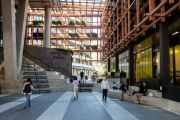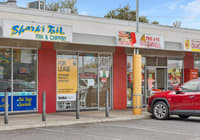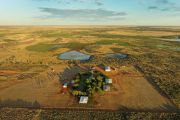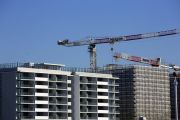What's going to fix Australia's housing market? Industry leaders weigh in
Large institutional investors like super funds, mutual funds, insurance companies, wealth funds and life companies are set to be tapped for additional capital to pour into Australia’s critically under-supplied housing market.
Minister for Housing Julie Collins told the AFR Property Summit on Tuesday that institutional investment was one of the pieces in the jigsaw puzzle to help solve the housing crisis.
“This government understands the role institutional investors could play in delivering more housing supply,” she said.
“Institutional investment that does occur in housing is primarily in niche sectors, such as residential aged-care facilities, student accommodation and subsidised affordable housing.
“In contrast, institutional investors have sizeable investments in Australian commercial, retail and industrial property. They also have extensive investments in international housing markets. We need to ensure a fit for purpose framework that welcomes this institutional investment in Australia.”
The determination to work with investors to increase the supply of homes, and thus put downward pressure on prices to make them more affordable, comes on the heels of the deal with the Greens that finally allows the federal government’s $10 billion housing program to go before parliament this week.
It includes the target of building 1.2 million new homes over the next five years.
But in the meantime, there’s still likely to be a fair amount of pain for home buyers, with prices expected to grow further for the rest of the year.
Nicola Powell, Domain’s chief of research and economics, also told the summit – attended by the country’s major players in the housing industry – that property prices will continue to rise, although at a slower rate than we’ve seen over the past year.
“In Sydney, house prices rose 5.3 per cent over the June sector which is a very strong rise for three months,” she said.
“That’s been very a unusual period but that type of property growth isn’t sustainable.
“We saw a little bit of FOMO coming out of the winter months, but we’re seeing new listings coming in, and total supply grow, so that should dampen down price growth too.”
She also said the 1.2 million target was likely to prove challenging.
“What we need is local government to supply shovel-ready land,” she said.
“There are many factors in developing and building new homes like the availability of finance, the level of demand and profitability, but the provision of shovel-ready land is critical and is going to be a major challenge.”
Yellow Brick Road executive chairman Mark Bouris, however, forecast that a projected rise in unemployment to 4.5 per cent, as well as the likelihood that few Australians would be given pay rises this year, could have a depressionary effect on housing prices.
With so many lenders coming off fixed rates to variable, that could also squeeze the market.
“For every 1 per cent rise in the NAIRU [Non-Accelerating Inflation Rate of Unemployment], we expect to see a 2 to 3 per cent fall in GDP [Gross Domestic Product],” he said.
“That’s growing now at under 2 per cent, which tells us we’ll go into negative territory, which means more business owners will be impacted and, as a result, will shed workers.
“And the two things that affect property prices the most are people losing jobs or not getting pay rises.”
While more homes could also go some way towards halting more price growth, Shane Oliver, head of investment strategy and chief economist at AMP agrees that it might be tough to supply 1.2 million new dwellings.
He believes the figure aimed for makes perfect sense, but the reality could stymie such bold ambitions.
“The question is, how realistic is it?” he asked. “It’s going to be a struggle with issues like our labour shortage, and material supply disruptions. But, hopefully, we’ll see land rolled out faster and development approvals given more quickly.
“We’ve struggled with the housing supply over the past five years, so how will the next five be any different?
“It’s good the government has put more of a focus on social and affordable housing but they should be looking closely at how to deliver it, too.”
One of the issues with more development has always been people’s NIMBYism, objecting to new housing in their suburbs.
Bouris suggested, to get over this hurdle, that Treasury considered a system of rewarding locals who encouraged development.
“Increasing density, the federal government says, is for the greater good of all Australians, so maybe they could give out tax rebates to those on the ground who agree,” he said.
“So, if there are 10 new developments in one area, providing, say, 10,000 new apartments, then there could be a zone-based tax rebate as a bottom-down incentive for people not objecting. At the moment, it could take three years to get a development approval from a local council and lots of objectors, but that could really help.”
Institutional investors supplying more housing for the rental market could be a game-changer too for many tenants looking for places to live, said Trina Jones, the NSW rental commissioner, formerly the chief executive of Homelessness NSW.
As well as investing in the Build To Rent (BTR) sector, they could also buy whole strata schemes and housing developments, and appoint professional managers to run the blocks.
“Right now, all the mum and dad investors who own properties are feeling the financial pressures and so when renters need repairs and maintenance done on their homes, it’s not always done,” Jones said.
“When you have larger scale government or institutional investors, you can make sure that those are done, which can make a huge difference to the quality of renters’ lives … If you take your car to a mechanic and they say they can’t afford to do safe repairs, you wouldn’t stand for it, so why could you excuse the owners of property from making their homes safe?”
Other things that need to be done to help renters include working with both investors and tenants to abolish no-grounds evictions, although with other rules in place to protect owners, and making sure tenants could keep pets, Jones believes.
A recent study found that Australia is the worst country in the developed world in which to rent, with the shortest average tenure time, advised Evan Thornley, executive chair of LongView Funds Management.
“That’s endemic across our system and it’s often the result of fragmented ownership,” he told the summit.
“The system isn’t working either for landlords – with an average return of about 6 per cent, which means they’d be better off putting their money into a superfund – or renters.
“The solution is moving towards a system with larger housing funds financing the physical real estate and then managing it with professional managers.”
For that to be effective, the system of government policies, incentives, grants and tax rebates needs to be much clearer and easy to understand, said Maree Kilroy, senior economist, construction and property forecasting, Oxford Economics.
“It’s a confusing police landscape that’s very difficult to navigate,” she said. “Perhaps we need fewer, more elegant and more simple policies.”Hopefully, a big part of providing more secure homes to rent will be provided by the BTR sector in the future, believes Brendan Coates, the Grattan Institute’s economic policy program director.
In Australia, currently, BTR accounts for only 0.2 per cent of the housing stock – compared to 5 per cent in the UK and 12 per cent in the US – but it is growing exponentially.
“It would be really good to see more of this adding to supply,” said Powell.










